Lee Jae-myung envisions efficient, powerful military for future warfare
Lee will shift strategic focus to enhance capability to counter nuclear, WMD threats
By Ji Da-gyumPublished : March 2, 2022 - 18:04
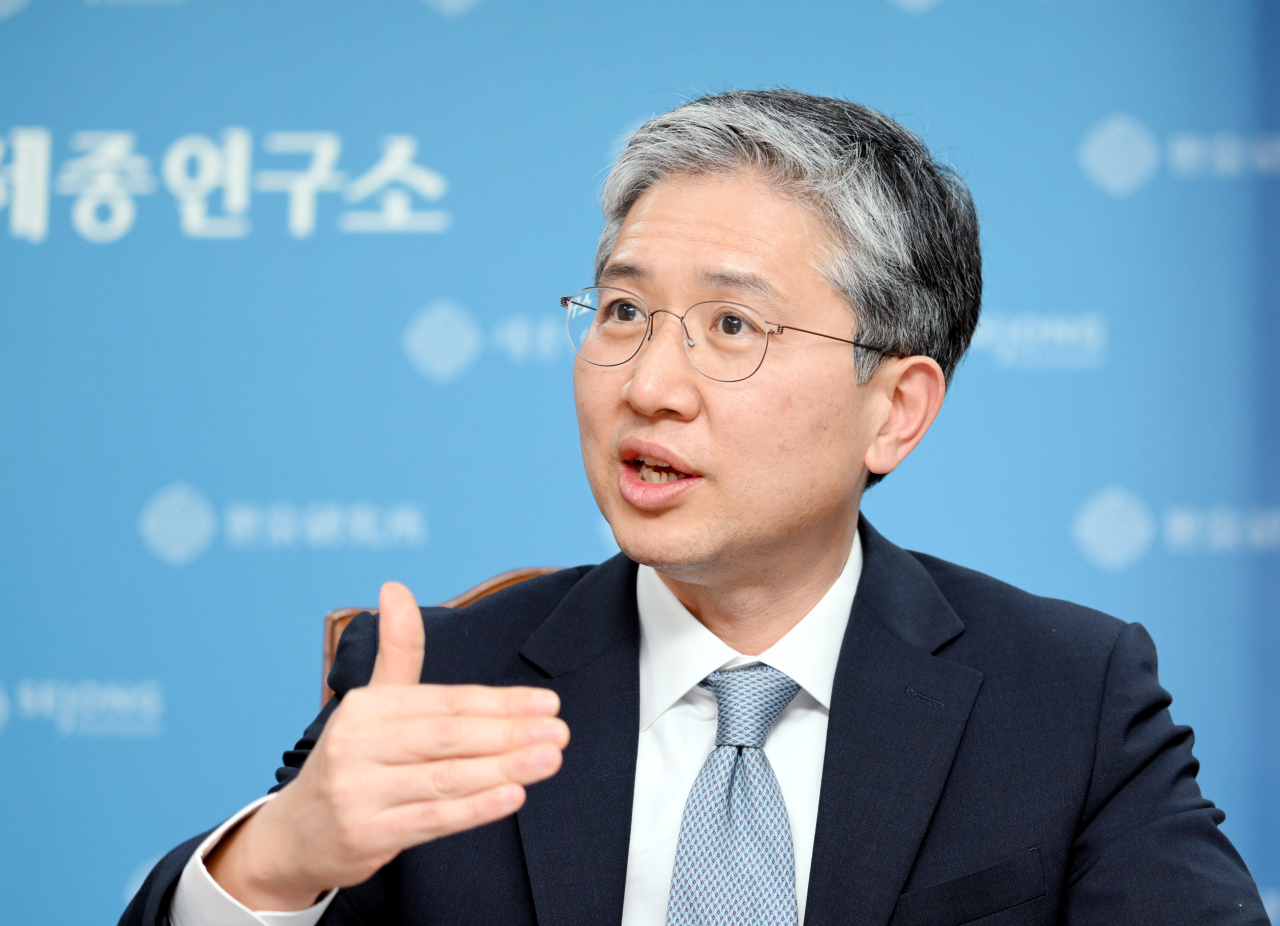
Presidential candidate Lee Jae-myung of the ruling Democratic Party of Korea will build up an efficient and powerful military prepared for future warfare, his adviser said in an interview with The Korea Herald.
South Korea has faced rapidly mounting North Korean nuclear and missile threats and new and emerging security challenges across all domains. The intricate regional dynamics in the Indo-Pacific have been compounded by the growing US-China rivalry and the heated arms race.
At this juncture, Lee views Seoul should recalibrate national defense and security strategies and restructure its defense spending to effectively and efficiently respond to the multifaceted menaces that have transformed the future battlefield.
Overall, Lee asks two big-picture questions in planning his defense strategy: First, how can South Korea enhance its military’s adaptability to the future battlefield and second, what are the essential capabilities to efficiently and effectively prepare for future warfare.
South Korea has faced rapidly mounting North Korean nuclear and missile threats and new and emerging security challenges across all domains. The intricate regional dynamics in the Indo-Pacific have been compounded by the growing US-China rivalry and the heated arms race.
At this juncture, Lee views Seoul should recalibrate national defense and security strategies and restructure its defense spending to effectively and efficiently respond to the multifaceted menaces that have transformed the future battlefield.
Overall, Lee asks two big-picture questions in planning his defense strategy: First, how can South Korea enhance its military’s adaptability to the future battlefield and second, what are the essential capabilities to efficiently and effectively prepare for future warfare.
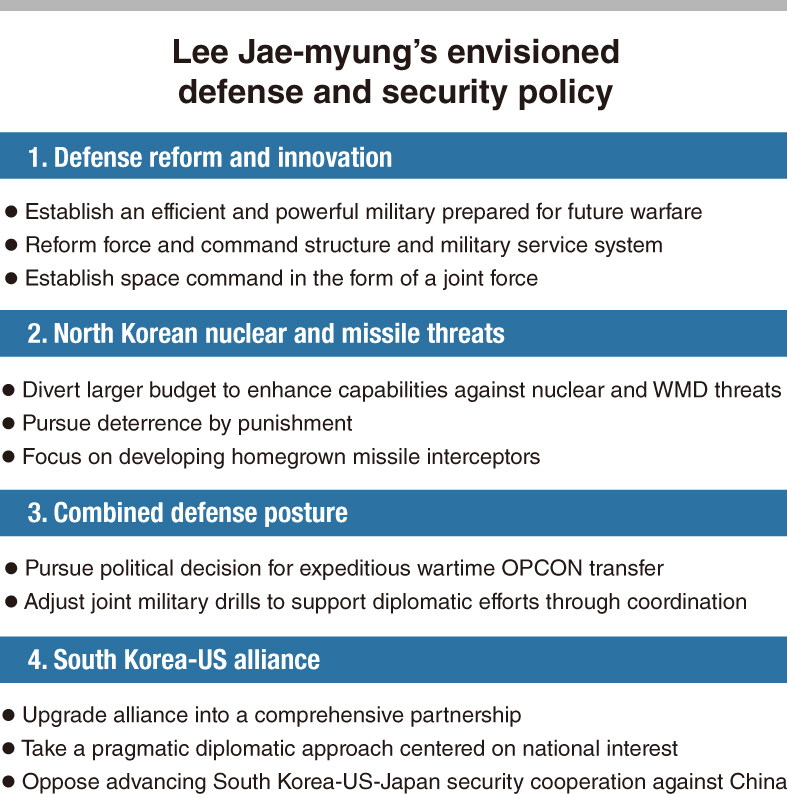
Defense reform and innovation
Above all, Lee will directly and expeditiously push forward far-reaching and fundamental defense reform and innovation to prepare for any future battlefields by incorporating the technologies of the Fourth Industrial Revolution into the South Korean military.
“We need an overall reform in warfighting concept, force and command structure, and military service system,” said Kim Jung-sup, who advises Lee on defense and security policies. Kim, a vice president at the Sejong Institute, also served as deputy minister for planning and coordination during his 27-year career at South Korea’s Defense Ministry.
Lee’s plan to expand a military operations area into space and establish a space command gives us a glimpse of how he will pursue defense innovation and modernize forces to address future and nontraditional threats emerging across all domains.
The space command will be launched as a joint force of the Army, Navy, and Air Force. The command will take the initiative in integrating efforts to build up space combat power and procure space assets, including early-warning satellites and microsatellites for surveillance and reconnaissance.
Lee also seeks to simplify the military’s command structure for swift operations and introduce a new hybrid military service system to foster the military’s expertise and proficiency and to prepare for a demographic cliff.
The presidential candidate is hoping to pursue a middle ground between conscription and an all-volunteer military.
Lee will reduce the number of conscripts from 300,000 to 150,000 during his term while increasing the number of professional noncommissioned officers by 50,000 through conscription. In addition, 50,000 civilian employees with expertise will be hired to support the military.
Priority on countering nuclear, WMD threats
Another key task to prepare for future warfare is to strategically reestablish clear priorities for developing military capabilities within its limited defense budget.
“Above all, we have to advance our weapons system and shift our focus toward reinforcing core military capabilities to respond to nuclear and Weapons of Mass Destruction (WMD) threats,” Kim said.
Essentially, Lee put a greater emphasis on reinforcing South Korea’s independent core military capabilities to respond to North Korea’s existential nuclear and WMD threats and acquiring high-tech weapons including a nuclear-powered submarine.
Lee views it as imperative that South Korea should now shift its defense and security strategies and restructure the defense budget.
The reality is that more than 70 percent of the budget earmarked for the “force improvement program” has been channeled into responding to North Korea’s conventional threats. But less than 30 percent has been assigned to counter nuclear and WMD threats despite its gravity.
Kim underscored that South Korea should divert a larger part of its defense spending to enhance its military capabilities against nuclear and WMD threats.
“The restructuring of our defense expenditure is necessary,” Kim said.
Kim also explained that it is indispensable for South Korea to develop high-tech “strategic assets” such as a nuclear-powered submarine amid the rapidly changing and complicated security dynamics in Northeast Asia.
Therefore, the redirection of military spending concurrently aims to reinforce military strength against potential regional threats in Northeast Asia, where the arms race has surged amid the intensifying US-China competition.
Deterrence by punishment
Also noteworthy, “deterrence by punishment” is the core of Lee’s strategy to efficiently and effectively counter North Korean nuclear and missile threats.
“First and foremost, we need to deter North Korea from considering using nuclear weapons by firmly acquiring the capability to punish and retaliate,” Kim told The Korea Herald. “Deterrence essentially means that we can clearly make North Korea aware of the ruinous costs that they will pay for use of nuclear weapons.“
Seoul should build up military power and capability to punish and retaliate against Pyongyang and strike high payoff targets. Lee will advance South Korea’s ballistic missile programs and develop precision-strike capabilities.
Lee also seeks to expedite the establishment of the indigenous missile defense system, known as Korea Air and Missile Defense, to counter North Korean nuclear and missile attacks.
But enhancing the country’s multilayered missile defense system, which is deterrence by denial, is a complementary component in his strategy to counter North Korea’s nuclear and missile threats.
As North Korea bolsters its missile and nuclear capabilities in quantity and quality, it will reduce the effectiveness of deterrence by denial.
Lee admits there are limitations to missile defenses, but South Korea should still strategically design its missile defense architecture with priority to protect high-value core assets.
“We should develop missile defense capabilities and a layered missile defense system in preparation for a scenario where deterrence fails,” Kim said. “Additionally, we need to acquire the capability to quickly launch long-distance precision strikes against high payoff targets in North Korea in case of contingencies and all-out war.”
South Korea also should figure out effective and efficient ways to counter threats posed by North Korea’s artillery and multiple rocket launchers targeting the capital area.
In a nutshell, Seoul should find the balance between building offensive and defensive weapons against artillery threats.
Focus on developing homegrown interceptors
Presidential candidate Yoon Suk-yeol of the People Power Party endorses the purchase and installation of the US Terminal High Altitude Area Defense (THAAD) system to defend people in the metropolitan area.
But Lee sees that South Korea should reinforce the lower tier of a layered missile defense shield against North Korea’s short-range missiles traveling at relatively low altitudes and targeting the capital area.
Patriot interceptors and homegrown Cheongung II missiles, which can engage incoming ballistic missiles at altitudes up to 40 km, are rather tailored to defending the metropolitan area.
The THAAD system provides the upper tier of a multilayered missile defense system and is capable of intercepting missiles at altitudes of 40-150 km in their terminal phase.
But a THAAD battery will not be able to catch them if North Korea’s newly developed triple set of KN-23, KN-24, KN-25 solid-propellant, short-range ballistic missiles and Scud missiles travel on a lower, depressed trajectory.
Furthermore, South Korea should develop homegrown middle and upper-tier missile defense in light of fostering the national defense industry.
South Korea has signed a deal to export 4 trillion won ($3.32 billion) worth of Cheongung II or M-SAM system to the United Arab Emirates, which Kim pointed to as a good precedent.
“I have to say that we have to consider the defense industry. South Korea has already invested more than 1 trillion won,” Kim said. “If we funnel 1.5 trillion won out of our (limited) defense budget into purchasing a THAAD battery, it will inevitably shrink the country’s defense industry.”
Seoul has accelerated the development of the long-range surface-to-air missile system (L-SAM), which is designed to shoot down hostile missiles at altitudes between 40 and 70 km, with the goal of advancing the original schedule of deploying the system by 2026.
In the 2030s, South Korea also plans to upgrade the L-SAM into the L-SAM II which can reportedly target missiles at altitudes of 40 to 150 km.
More importantly, it is imperative for South Korea to advance its own missile defense system as it requires continuous upgrades corresponding to North Korea’s missile development.
“Building a missile defense system is not a one-off project,” Kim said. “An additional installation of a THAAD battery will not be a panacea.”
Above all, Lee will directly and expeditiously push forward far-reaching and fundamental defense reform and innovation to prepare for any future battlefields by incorporating the technologies of the Fourth Industrial Revolution into the South Korean military.
“We need an overall reform in warfighting concept, force and command structure, and military service system,” said Kim Jung-sup, who advises Lee on defense and security policies. Kim, a vice president at the Sejong Institute, also served as deputy minister for planning and coordination during his 27-year career at South Korea’s Defense Ministry.
Lee’s plan to expand a military operations area into space and establish a space command gives us a glimpse of how he will pursue defense innovation and modernize forces to address future and nontraditional threats emerging across all domains.
The space command will be launched as a joint force of the Army, Navy, and Air Force. The command will take the initiative in integrating efforts to build up space combat power and procure space assets, including early-warning satellites and microsatellites for surveillance and reconnaissance.
Lee also seeks to simplify the military’s command structure for swift operations and introduce a new hybrid military service system to foster the military’s expertise and proficiency and to prepare for a demographic cliff.
The presidential candidate is hoping to pursue a middle ground between conscription and an all-volunteer military.
Lee will reduce the number of conscripts from 300,000 to 150,000 during his term while increasing the number of professional noncommissioned officers by 50,000 through conscription. In addition, 50,000 civilian employees with expertise will be hired to support the military.
Priority on countering nuclear, WMD threats
Another key task to prepare for future warfare is to strategically reestablish clear priorities for developing military capabilities within its limited defense budget.
“Above all, we have to advance our weapons system and shift our focus toward reinforcing core military capabilities to respond to nuclear and Weapons of Mass Destruction (WMD) threats,” Kim said.
Essentially, Lee put a greater emphasis on reinforcing South Korea’s independent core military capabilities to respond to North Korea’s existential nuclear and WMD threats and acquiring high-tech weapons including a nuclear-powered submarine.
Lee views it as imperative that South Korea should now shift its defense and security strategies and restructure the defense budget.
The reality is that more than 70 percent of the budget earmarked for the “force improvement program” has been channeled into responding to North Korea’s conventional threats. But less than 30 percent has been assigned to counter nuclear and WMD threats despite its gravity.
Kim underscored that South Korea should divert a larger part of its defense spending to enhance its military capabilities against nuclear and WMD threats.
“The restructuring of our defense expenditure is necessary,” Kim said.
Kim also explained that it is indispensable for South Korea to develop high-tech “strategic assets” such as a nuclear-powered submarine amid the rapidly changing and complicated security dynamics in Northeast Asia.
Therefore, the redirection of military spending concurrently aims to reinforce military strength against potential regional threats in Northeast Asia, where the arms race has surged amid the intensifying US-China competition.
Deterrence by punishment
Also noteworthy, “deterrence by punishment” is the core of Lee’s strategy to efficiently and effectively counter North Korean nuclear and missile threats.
“First and foremost, we need to deter North Korea from considering using nuclear weapons by firmly acquiring the capability to punish and retaliate,” Kim told The Korea Herald. “Deterrence essentially means that we can clearly make North Korea aware of the ruinous costs that they will pay for use of nuclear weapons.“
Seoul should build up military power and capability to punish and retaliate against Pyongyang and strike high payoff targets. Lee will advance South Korea’s ballistic missile programs and develop precision-strike capabilities.
Lee also seeks to expedite the establishment of the indigenous missile defense system, known as Korea Air and Missile Defense, to counter North Korean nuclear and missile attacks.
But enhancing the country’s multilayered missile defense system, which is deterrence by denial, is a complementary component in his strategy to counter North Korea’s nuclear and missile threats.
As North Korea bolsters its missile and nuclear capabilities in quantity and quality, it will reduce the effectiveness of deterrence by denial.
Lee admits there are limitations to missile defenses, but South Korea should still strategically design its missile defense architecture with priority to protect high-value core assets.
“We should develop missile defense capabilities and a layered missile defense system in preparation for a scenario where deterrence fails,” Kim said. “Additionally, we need to acquire the capability to quickly launch long-distance precision strikes against high payoff targets in North Korea in case of contingencies and all-out war.”
South Korea also should figure out effective and efficient ways to counter threats posed by North Korea’s artillery and multiple rocket launchers targeting the capital area.
In a nutshell, Seoul should find the balance between building offensive and defensive weapons against artillery threats.
Focus on developing homegrown interceptors
Presidential candidate Yoon Suk-yeol of the People Power Party endorses the purchase and installation of the US Terminal High Altitude Area Defense (THAAD) system to defend people in the metropolitan area.
But Lee sees that South Korea should reinforce the lower tier of a layered missile defense shield against North Korea’s short-range missiles traveling at relatively low altitudes and targeting the capital area.
Patriot interceptors and homegrown Cheongung II missiles, which can engage incoming ballistic missiles at altitudes up to 40 km, are rather tailored to defending the metropolitan area.
The THAAD system provides the upper tier of a multilayered missile defense system and is capable of intercepting missiles at altitudes of 40-150 km in their terminal phase.
But a THAAD battery will not be able to catch them if North Korea’s newly developed triple set of KN-23, KN-24, KN-25 solid-propellant, short-range ballistic missiles and Scud missiles travel on a lower, depressed trajectory.
Furthermore, South Korea should develop homegrown middle and upper-tier missile defense in light of fostering the national defense industry.
South Korea has signed a deal to export 4 trillion won ($3.32 billion) worth of Cheongung II or M-SAM system to the United Arab Emirates, which Kim pointed to as a good precedent.
“I have to say that we have to consider the defense industry. South Korea has already invested more than 1 trillion won,” Kim said. “If we funnel 1.5 trillion won out of our (limited) defense budget into purchasing a THAAD battery, it will inevitably shrink the country’s defense industry.”
Seoul has accelerated the development of the long-range surface-to-air missile system (L-SAM), which is designed to shoot down hostile missiles at altitudes between 40 and 70 km, with the goal of advancing the original schedule of deploying the system by 2026.
In the 2030s, South Korea also plans to upgrade the L-SAM into the L-SAM II which can reportedly target missiles at altitudes of 40 to 150 km.
More importantly, it is imperative for South Korea to advance its own missile defense system as it requires continuous upgrades corresponding to North Korea’s missile development.
“Building a missile defense system is not a one-off project,” Kim said. “An additional installation of a THAAD battery will not be a panacea.”
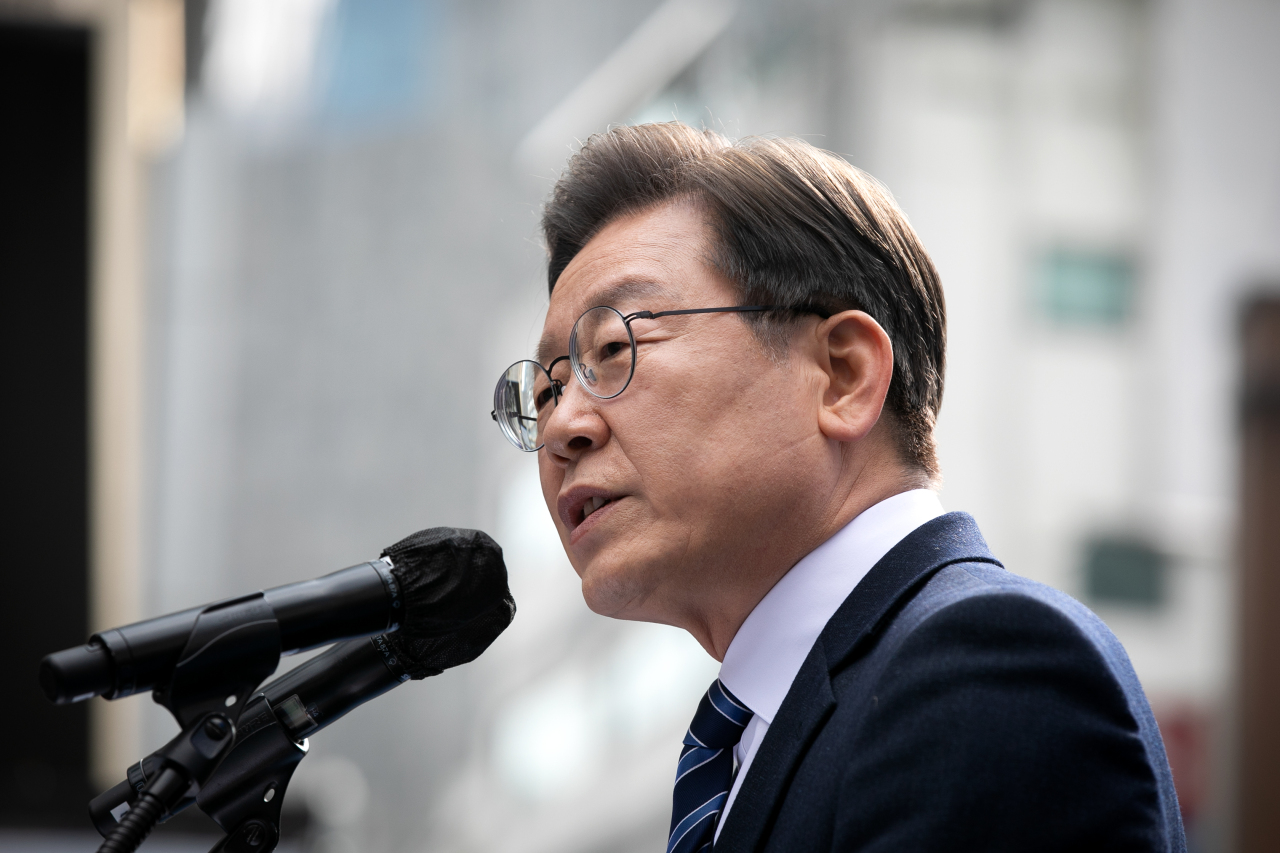
OPCON transfer during presidency
Lee seeks to expeditiously complete the transfer of wartime operational control (OPCON) within his term if he is elected.
The presidential candidate will “promptly” meet conditions required for the wartime OPCON transition while respecting the bilaterally agreed transition plan. But a common understanding on the matter between Washington and Seoul is also essential.
“We have to make working-level and military efforts to meet conditions. But at the same time, there should be a consensus or shared view on the expeditious transfer of wartime OPCON between the two presidents or defense chiefs,” Kim said. “A political decision is also needed.”
Seoul and Washington can also adjust their joint military drills, Lee believes, if it supports diplomatic efforts to achieve North Korea’s complete denuclearization, which is the “most significant” issue for South Korean security.
“We can make a flexible but prudent decision on the timing, scale, and way of conducting the South Korea-US joint military exercise if this is a decisive determinant in resuming nuclear negotiations,” Kim said. “I don’t think the US will take a rigid stance on the matter.”
Put national interest first
In general, Lee sees that the South Korea-US alliance should be developed into a comprehensive partnership in a wide range of fields, including global health, emerging technology, and supply chain resilience, as previously agreed at the summit last May.
But Lee will fundamentally adhere to its pragmatic diplomatic approach, which centers on national interest, in shaping the future of the South Korea-US security alliance, particularly in a volatile and complex security environment in the Indo-Pacific region.
“We should first consider our regional strategy, which will be the basis for establishing the South Korea-US alliance and our relations with China and Japan,” Kim said.
Specifically, Lee views South Korea as needing to discreetly participate in a trilateral security cooperation between South Korea, Japan, and the US, although he recognizes its significance in achieving complete denuclearization and maintaining peace and stability on the Korean Peninsula.
The Biden administration recently announced its Indo-Pacific engagement strategy that aims to align and coordinate the three countries’ regional strategies and handle North Korea issues through trilateral channels.
But Lee will not endorse the idea of advancing the trilateral security cooperation into a coalition to counter China.
“South Korea-US-Japan security cooperation is basically necessary, but we should mull over the scope, level, and characteristics of the coordination,” Kim said.
“I don’t think it is desirable for us to move toward solidifying confrontation between the coalitions,” Kim added, referring to the trilateral cooperation among South Korea, Japan, and the US against the triangle of China, Russia, and North Korea.
Overall, Lee will “do his best” to take responsibility and make a contribution to the US Indo-Pacific strategy as an ally. But in view of national interest, he will have limited options in fully supporting Washington at the end of the day.
The presidential candidate seeks to firmly establish South Korea’s renewed role and position in the intricate regional dynamics and send a clear message to the US on what the country can or can’t do as an ally. At the same time, Lee will adhere to the consistent position of maintaining “autonomy” and prioritizing national interest.
“Our geopolitical reality is that neither the South Korea-US alliance nor the amicable relationship between South Korea and China can be sacrificed,” Kim said, “The US should, of course, understand that as an ally.”
By Ji Da-gyum (dagyumji@heraldcorp.com)
Lee seeks to expeditiously complete the transfer of wartime operational control (OPCON) within his term if he is elected.
The presidential candidate will “promptly” meet conditions required for the wartime OPCON transition while respecting the bilaterally agreed transition plan. But a common understanding on the matter between Washington and Seoul is also essential.
“We have to make working-level and military efforts to meet conditions. But at the same time, there should be a consensus or shared view on the expeditious transfer of wartime OPCON between the two presidents or defense chiefs,” Kim said. “A political decision is also needed.”
Seoul and Washington can also adjust their joint military drills, Lee believes, if it supports diplomatic efforts to achieve North Korea’s complete denuclearization, which is the “most significant” issue for South Korean security.
“We can make a flexible but prudent decision on the timing, scale, and way of conducting the South Korea-US joint military exercise if this is a decisive determinant in resuming nuclear negotiations,” Kim said. “I don’t think the US will take a rigid stance on the matter.”
Put national interest first
In general, Lee sees that the South Korea-US alliance should be developed into a comprehensive partnership in a wide range of fields, including global health, emerging technology, and supply chain resilience, as previously agreed at the summit last May.
But Lee will fundamentally adhere to its pragmatic diplomatic approach, which centers on national interest, in shaping the future of the South Korea-US security alliance, particularly in a volatile and complex security environment in the Indo-Pacific region.
“We should first consider our regional strategy, which will be the basis for establishing the South Korea-US alliance and our relations with China and Japan,” Kim said.
Specifically, Lee views South Korea as needing to discreetly participate in a trilateral security cooperation between South Korea, Japan, and the US, although he recognizes its significance in achieving complete denuclearization and maintaining peace and stability on the Korean Peninsula.
The Biden administration recently announced its Indo-Pacific engagement strategy that aims to align and coordinate the three countries’ regional strategies and handle North Korea issues through trilateral channels.
But Lee will not endorse the idea of advancing the trilateral security cooperation into a coalition to counter China.
“South Korea-US-Japan security cooperation is basically necessary, but we should mull over the scope, level, and characteristics of the coordination,” Kim said.
“I don’t think it is desirable for us to move toward solidifying confrontation between the coalitions,” Kim added, referring to the trilateral cooperation among South Korea, Japan, and the US against the triangle of China, Russia, and North Korea.
Overall, Lee will “do his best” to take responsibility and make a contribution to the US Indo-Pacific strategy as an ally. But in view of national interest, he will have limited options in fully supporting Washington at the end of the day.
The presidential candidate seeks to firmly establish South Korea’s renewed role and position in the intricate regional dynamics and send a clear message to the US on what the country can or can’t do as an ally. At the same time, Lee will adhere to the consistent position of maintaining “autonomy” and prioritizing national interest.
“Our geopolitical reality is that neither the South Korea-US alliance nor the amicable relationship between South Korea and China can be sacrificed,” Kim said, “The US should, of course, understand that as an ally.”
By Ji Da-gyum (dagyumji@heraldcorp.com)










![[Kim Seong-kon] Democracy and the future of South Korea](http://res.heraldm.com/phpwas/restmb_idxmake.php?idx=644&simg=/content/image/2024/04/16/20240416050802_0.jpg&u=)




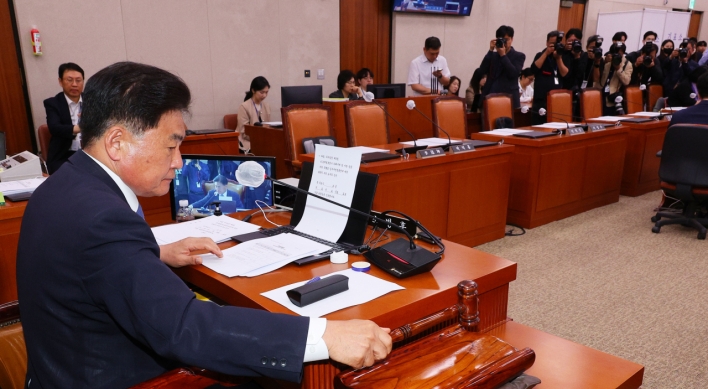

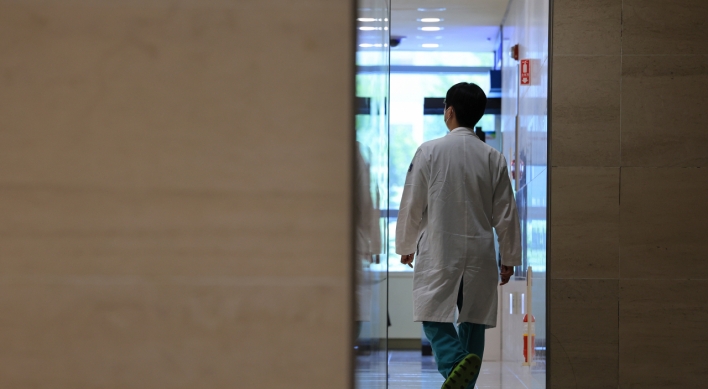


![[Today’s K-pop] Zico drops snippet of collaboration with Jennie](http://res.heraldm.com/phpwas/restmb_idxmake.php?idx=642&simg=/content/image/2024/04/18/20240418050702_0.jpg&u=)